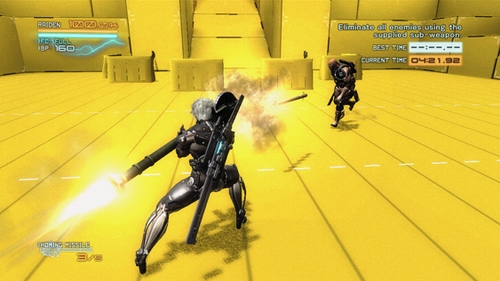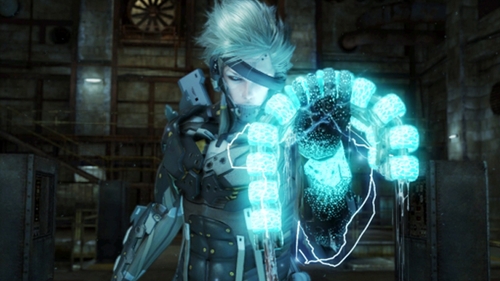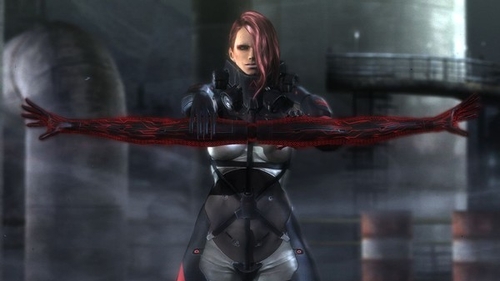Hideo Kojima’s Metal Gear series celebrates its 26th anniversary this year. It’s a party to which I had no interest in attending, figuratively speaking. Since the first “Metaru Gia Sorid” on PS1, I’ve skirted around the game. It’s no secret that I don’t have the attention span for sneak-em-ups and the thought of travelling around in cardboard boxes and enduring feature-length cutscenes was not for me. I have subsequently missed every successive Metal Gear game across all the platforms. Until now.
So why is someone like me without any interest in the Metal Gear franchise, so enthused to play Metal Gear Rising: Reveangeance? Did the flurry of media lure me on board the hype train? Truthfully, yes. Not once during the extreme frenetic trailers, did I think of the possibility of stealth and death-by-cutscene creeping into this new game. All I wanted to do was slice people up into teeny tiny hors d’oeuvres.
So how does Metal Gear Rising: Reveangeance (henceforth shortened to just “Revengeance”) play for someone who is unburdened of experiencing past Metal Gear games? The answer lies in wait, after the jump.
The story in Revengeance revolves around half-man, half-machine ninja Raiden, who has found employment with a private military security company. A mission goes south in deepest Africa, and an encounter with a rival security company leaves a lot more hurt than his pride. However, some months later his time for vengeance is at hand when he learns that the same rival company is planning a coup in another country. Raiden is sent to investigate and becomes embroiled in a plot that goes far below the surface. While there is philosophical banter about the nature of war, the whodunit story isn’t all that complex. Canonically speaking, the game takes place after the events of Metal Gear Solid 4 and—if like me, you have not played that—things like PMC, SOP, and other TLAs will be foreign to you. When Raiden and his cohorts make references to past events, it does feel a little alienating to newcomers.
Unlike some other games, Revengeance doesn’t provide a lot of “on the job” training. Some of combat mechanics are taught in the rudimentary VR training sessions that take place before the main mission starts. But there is no match for practice. Revengeance focuses heavily on swordplay, a skill that Raiden has in spades. Wielding his HF blade, he can use a combination of light and heavy attacks to slice his way through enemies. A new cutting system makes its debut in Revengeance, so-called Blade Mode. Engaging this mode give Raiden the ability to control the direction and speed of his sword strikes, to amputate his enemies, break through gaps in enemy armour, and deflecting gun fire. As the bodies pile up, the Blade Mode meter fills and when it is full, Raiden is able to perform a “Zan-Datsu”. Reminiscent of Sub-Zero’s fatality from Mortal Kombat, “Zan-Datsu” reveals a specific weak point in the enemy that Raiden must cut to inflict massive damage.
In the heat of battle when you are surrounded by enemies, it can become difficult to time and perfectly slice through the required areas, especially when you’re looking for left arms to harvest (don’t ask). However with practice comes rewards. The more flashy zan-datsus that you perform, the less damage you take, and the more lefties you collect, the better you are graded after each level and the more BP that you receive. “BP” stands for Battle Points, or as I like to call it, Badass Points. It’s the in-game currency that you can use to upgrade your weapons and their enhancements, fuel cells, and even buy a sombrero. Revengeance’s inventory system is accessible from a press of the D-pad, and you can choose disposable items to use be they grenades, lures, or even the venerable cardboard box to hide in. You can also choose to equip health packs, and given the incredible complexity of Raiden’s suit, you’d expect that the health packs would be automatically applied when his health was critical. However, in the midst of a frenetic battle, Raiden actually has to come to a complete stop before you are able to access the inventory to select items.
Another noticeable niggle is that costume choices don’t reflect in the cutscenes. I wouldn’t have expected that given the usual fastidious nature of Kojima Productions and Platinum Games. What I also didn’t expect was an unruly camera. The last time a dodgy camera killed what would have been an otherwise great experience was 2011’s Epic Mickey (Ed: And let’s not forget Alice: Madness Returns too). While Revengeance’s camera wasn’t that level of terrible, it does give you a fair share of frustration. It’s as if the camera has a mind of its own, causing the player to lose their sense of direction, and losing sight of items they want to collect and the enemies they need to clobber. While there is a lock-on mechanism to make this a bit easier, there are several moments especially so in tight spaces where the camera loses focus of Raiden and his enemies and opts to show you the views from crotch level. When you’re trophy hunting—there are ones for taking no damage whatsoever in boss battles—a dodgy camera can make an an already exasperating situation worse, especially in the harder modes of difficulty.
Enemies come in all sizes, big and small but they’re united in their hatred of you. They’re coordinated, aggressive, and colder than the steel in Raiden’s HF blade. Theywill actively attempt to break through your defenses and overpower you with their numbers. Therefore, parrying becomes key to survival. You need to flick your controller in the direction of the incoming attack and press a button at the critical moment. That itself isn’t necessarily that easy to players who might be novices to such defense systems like those seen in Castlevania: Lords of Shadow and Bayonetta.
Graphically, Revengeance isn’t a prize fighter but it’s no slouch either. Given the military subject material, the colour palette is composed predominantly of browns, greys, and blues. The environment textures are equally average and there really isn’t much variety to the locales you visit. Thankfully the frame rate doesn’t skip a beat, and manages to keep up with the blistering action. To keep in sync with the heart-racing action, the soundtrack combines fast electronica and heavy rock. Depending on your musical tastes, the killer tunes might be more miss than hit.
Revengeance might be on the short side, but it’s chock full of over-the-top action. There is great replay value for the completionists from all the VR missions to find and complete to the various titles and top ranks to achieve. And some of the trophies will prove fiendish even for the experienced hack n’ slasher. Raiden earns titles based on the way players complete the game. A weather-appropriate title of “Divine Wind” is awarded to players who can complete the campaign in three hours without dying, while the “rain shower” title is bestowed to games who do it in 10 hours and die a lot. If that’s the yardstick, I might just have to award myself the title of “Gentlest of breezes”.
As Raiden’s skills grew, so did my confidence levels as I progressed during the game. It really is a rewarding feeling when you successfully parry, counter-attack, and go all zan-datsu on your enemies. Cutting them up into little pieces never seemed to lose its appeal. Newcomers to the game won’t feel the warmth of any intro cutscenes/flashbacks to clue them in on past experiences of the protagonist. Maybe the story doesn’t say much, but Raiden’s HF blade does a lot of talking. Practice makes perfect and when done right, the combat in Revengeance is utterly chaotic and bloody to behold, although an unruly camera can spoil the fun at times. When it comes to hack n’ slasher games I’ve played in recent years, Revengeance is certainly a cut above the rest.
Final Score: 8 bloodsoaked prawns out of 10.
Detailed information:
Developer: Platinum Games
Publisher: Konami
Distributor: Ster-Kinekor
Platform: PS3 (reviewed), Xbox 360
Age Rating: 16
RRP: R599
Website: www.konami.jp/mgr/





